Bitcoin Node: What It Is And Why You Should Run One
Understanding the importance of running a Bitcoin Node is vital to start self-validating as an economic participant in the Bitcoin ecosystem. In this guide, we'll explore the core concepts of what a Bitcoin Node entails and how it functions.
What's a Bitcoin Node
A Bitcoin Node is a device that runs the Bitcoin Core software. It is one of the most important pillars of the Bitcoin Network and represent its true decentralization and trustless nature.
Basically, it's a computer that runs the Bitcoin Core and partecipates in the Bitcoin Network by doing functions such as:
- Verify transactions: Nodes validate and verify all incoming transactions to ensure they adhere to the rules of the Bitcoin protocol. This includes checking for things like double spending and verifying that the sender has the necessary funds to make the transaction.
- Block Validation: Nodes also validate newly created blocks in the blockchain. They check that the blocks adhere to the consensus rules, including the Proof of Work, timestamp, and other protocol-specific criteria.
- Relaying Information: Nodes share validated transactions and blocks with their peers in the network, helping to propagate this information efficiently. This process ensures that all nodes eventually have the same information, maintaining network consensus.
- Wallet Functionality: Some nodes such as the original Bitcoin Core or Bitcoin Knots, serve as the foundation for Bitcoin wallets. They allow users to create, manage, and sign transactions, enhancing user privacy and security.
- Mining: While most mining operations are now specialized, in the early days of Bitcoin, nodes were responsible for mining new blocks by attempting to solve the Proof of Work puzzle. However, this role has since been largely taken over by mining pools and specialized hardware.
| Term | Definition |
|---|---|
| 🌐 Bitcoin Node | A computer or device that runs Bitcoin software and participates in network activities like transaction validation and block propagation. |
| 🏛️ Full Node | A type of Bitcoin Node that stores the complete blockchain, validates transactions independently, and contributes to the network's security and decentralization. |
| 📱 SPV (Simplified Payment Verification) | A lightweight Bitcoin Node that doesn't store the full blockchain, relying on other nodes for transaction validation, suitable for mobile and resource-constrained devices. |
| 🔄 IBD (Initial Block Download) | The process by which a Bitcoin Node downloads and validates the entire blockchain, from the genesis block to the most recent transactions, during its setup. |
| 📜 Consensus Rules | Predefined rules followed by all Bitcoin Nodes to achieve consensus on transaction validation, block creation, and overall network integrity. |
| 🌐 Sybil Attack | An attack in which an adversary creates multiple fake nodes to control a significant portion of the network, undermining its security and decentralization. |
| ⛏️ Mining Pool | A group of miners who combine their computational resources to increase their chances of solving blocks and earning block rewards, managed by a pool coordinator. |
| 🆙 SegWit (Segregated Witness) | A protocol upgrade in 2017 that changed how data was stored in Bitcoin blocks, allowing for more transactions per block and improving network scalability. |
| ☂️ Umbrel | An open-source platform for running a Bitcoin Node and various related apps, making it accessible for self-hosting and participating in the Bitcoin network. |
| 💼 Hardware Wallet | A specialized device for securely storing Bitcoin private keys offline, providing enhanced security compared to software wallets. |
How A Bitcoin Node Works

What exactly are the roles of the thousands of Bitcoin nodes distributed across the globe? What a Bitcoin Node do?
A Node is a crucial component of the Bitcoin network, responsible for validating and propagating transactions to ensure the integrity and security of the system. Here's how a Bitcoin Node works:
Step 1: Transaction Broadcasting
When a new Bitcoin transaction is created and signed by the sender's wallet, it is broadcasted to the network. This means that the transaction is sent to multiple Bitcoin Nodes.
Step 2: Initial Validation
Upon receiving a transaction, each Bitcoin Node performs a series of checks to determine its validity. These checks are essential to maintaining the integrity of the blockchain and preventing fraud. The questions nodes seek to answer include:
- Ownership Verification: Does the sender's wallet address have a sufficient balance to cover the coins they want to spend? In other words, do they actually own the coins they are trying to send?
- Double Spending Check: Is this transaction trying to spend the same coins in multiple transactions simultaneously? Double spending is a critical issue that needs to be prevented.
- Authorization and Signature Verification: Has the transaction been properly authorized and signed using the sender's private key? This ensures that only the legitimate owner of the funds can initiate the transaction.
- Ruleset Compliance: Does the transaction adhere to the current Bitcoin protocol rules? This is crucial to maintain consistency and security within the network.
Step 3: Independent Validation
Each Bitcoin Node independently conducts these validation checks on every incoming transaction. This process ensures that every transaction is thoroughly examined for its validity.
Characteristics of a Bitcoin Node
- Verifiability: Anyone can run a Bitcoin Node, and every node must verify every transaction. This transparency ensures that the network remains trustless and resistant to manipulation.
- Redundancy: Redundancy is a fundamental principle of the Bitcoin network. Every node on the network independently validates transactions, reducing the risk of accepting invalid data. This redundancy is essential for network security.
- Security: Nodes employ cryptographic methods to verify transactions, blockchain data, transaction history, and wallet balances. This cryptographic security is a cornerstone of Bitcoin's trustless nature.
Bitcoin Node Safety
The redundancy and distributed nature of Bitcoin Nodes help safeguard the network against various attacks, including:
- Eclipse Attacks: Attackers attempting to manipulate a single node by surrounding it with false connections find it challenging because Bitcoin nodes connect to numerous independent peers. This makes it improbable that all inbound connections are compromised.
- DDoS Attacks: Distributed denial of service attacks, which flood a network with useless traffic to disrupt its operation, are impractical against Bitcoin's widely distributed network of validating nodes. The trustless nature of these nodes ensures that overwhelming and crippling the network is a formidable task.
- Forks: Running your own node to independently verify your transactions holds significance. Moreover, it grants you the capacity to either support or oppose proposed alterations to the network's protocols, commonly referred to as forks, based on your preferences.
What A Bitcoin Node Cannot Do
One common misconception about Bitcoin Nodes is the belief that more nodes automatically equate to a stronger network. In reality, the sheer quantity of nodes alone does not significantly enhance network performance.
Nodes only hold value when they are economically relevant, meaning that their operators, owners, or relying parties actively use them to validate their Bitcoin holdings and transactions.
The act of verifying transactions and coins by each user plays a crucial role in fortifying the network's economic integrity. This verification process helps identify and eliminate counterfeit coins, preventing SPV wallets or IOU holders from unknowingly propagating fraudulent transactions.
Attempts to employ a Sybil attack, as seen during the blocksize war, proved largely ineffective. The key point to remember is that the demand and price of Bitcoin, whether existing or newly created, are determined by the market. The majority of market participants rigorously assess the Bitcoin they acquire or hold, contributing to the network's overall robustness.
Sybil nodes, which lack transaction verification, are essentially pointless. In the midst of the blocksize war, some individuals established hundreds or even thousands of nodes on cloud service providers, but these nodes had minimal impact on network security or performance.
Quarterly reminder that “running a node” doesn’t nothing to bitcoin. Anyone can Sybil 10k nodes on AWS.
— NVK ⚡️🌞 nvk.org/nostr (@nvk) February 4, 2023
Self validating as an economic actor in Bitcoin is the real “running a Bitcoin”
Types of Bitcoin Nodes
There are many types of Bitcoin Nodes, both in software and hardware flavors. Let's have a look at the most prominent ones.
Software
- Full Nodes: These nodes perform all of the functions mentioned above. They download, validate, and store the entire blockchain, making them crucial for the security and integrity of the network.
- Pruned Nodes: These nodes maintain a pruned version of the blockchain, which means they only keep a subset of the most recent blocks. This reduces the storage requirements while still participating in transaction validation and network security.
- Lightweight Nodes (SPV Nodes): Simplified Payment Verification (SPV) nodes are more resource-efficient. They don't download the entire blockchain but instead rely on full nodes for transaction and block verification. They are suitable for users who want to use Bitcoin with minimal storage and bandwidth requirements.
- Mining Nodes: These nodes are specialized machines used by miners to compete in the Proof of Work process. They focus on solving cryptographic puzzles to add new blocks to the blockchain.
As Bitcoin Core, the original Bitcoin Node coming from the Bitcoin developers, supports Windows, Mac and Linux, so basically most of the hardware can run Bitcoin. However, some companies built specialized hardware (and also software that runs a customized version of Bitcoin Core).
Devices
Simply running a Bitcoin Node on Amazon AWS or similar cloud services can be limited in its usefulness, as it's an infrastructure you don't have full control over.
While it can contribute to the network by bootstrapping other nodes, your control remains restricted. Running a node on your own connection, using your own hardware in the security of your home or company, is more impactful and useful.
If you can run a node without direct internet access but rely on a satellite to download the Bitcoin blockchain and reconcile it with internet data, that's even better.
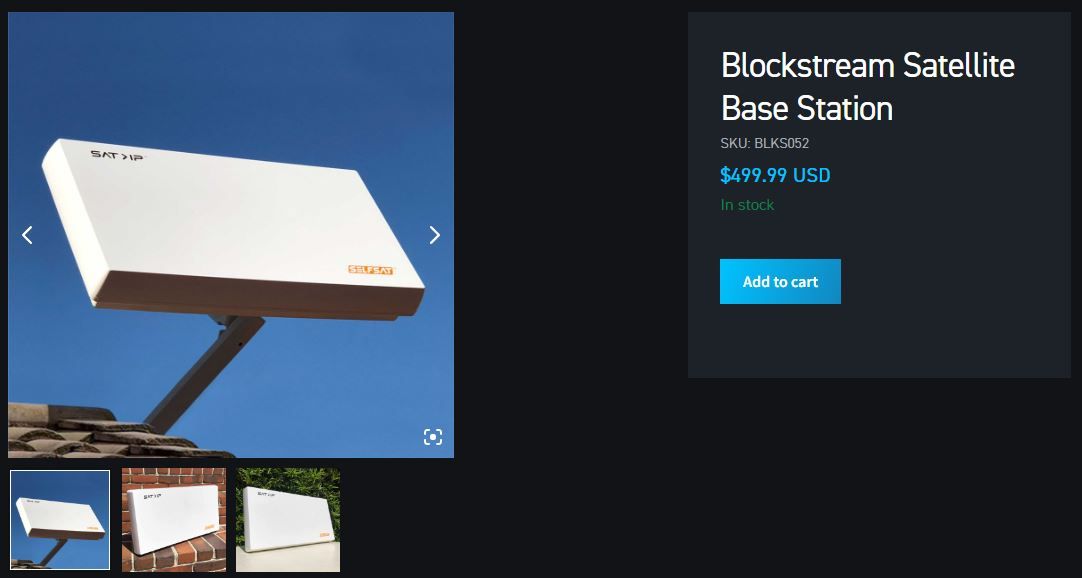
Blockstream offers satellite kits for this purpose, allowing you to run your node with space-based data. You can explore and purchase these kits from the official Blockstream Store by searching for "Satellite."
👉 Click here to learn more about the Bitcoin Satellite Station by Blockstream.
While it's possible for anyone to install Bitcoin Core software on their computer and run it, this might not be ideal for everyone due to the necessity of downloading a blockchain that can be several gigabytes in size.
In recent years, numerous companies have emerged, offering specialized software typically based on Linux or ARM, designed specifically for running a Bitcoin Node on low-powered devices like a Raspberry Pi.
This approach allows individuals to self-host their Bitcoin node at home, connect it to storage, and keep it online 24/7 at minimal costs. For reference, a Raspberry Pi consumes only 5-10 watts of power, which is less than that of a typical kitchen light. Below, I'll provide a list of some of the leading all-in-one solutions for running a Bitcoin Node.
Umbrel Home
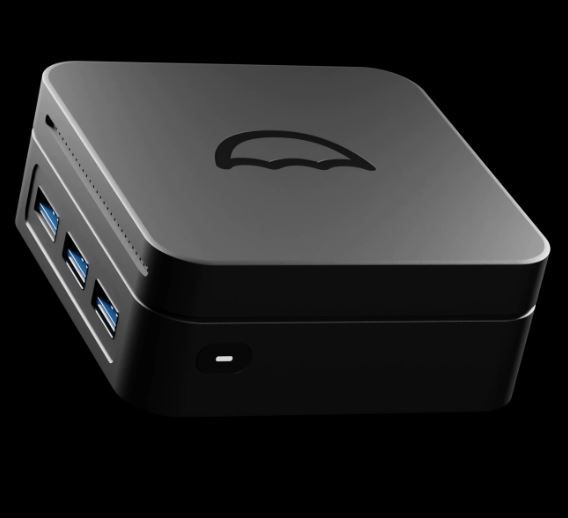
Umbrel has gained substantial popularity among Bitcoin enthusiasts, primarily for its capability to operate a Bitcoin Node and a range of related applications, including an Electrum Server (Electrs). It's likely the preferred choice for most users, offering not only Bitcoin apps but also media center and other self-hosted solutions.
However, purists may have reservations, as the inclusion of these additional apps and codes could potentially increase the attack surface. As a result, Umbrel is often likened to a media center operating system with its own app store, catering to self-hosting needs.
It can be accessed via pre-built hardware known as "Umbrel Home" featuring the UmbrelOS, or you have the option to install the software on various platforms, such as a Raspberry Pi 4, any Ubuntu/Debian system, or even a Virtual Private Server (VPS).
RoninDojo Tanto
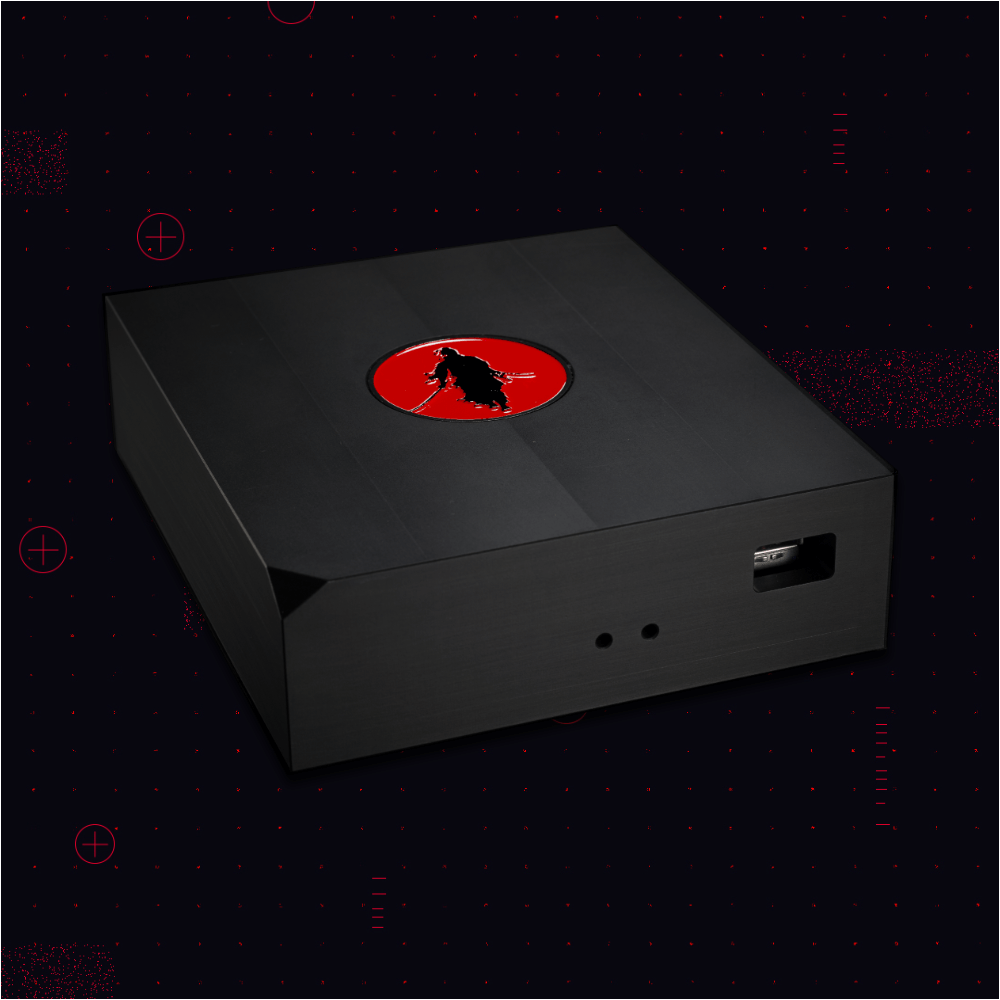
The Tanto, developed by RoninDojo, represents a hardware and software package that is entirely centered around Bitcoin. It includes a complete Bitcoin node and can be further enhanced with optional features like a mixer, thanks to the Whirlpool CoinJoin function.
RoninDojo is a dedicated team of free and open-source software (FOSS) developers, with their sole focus on creating the most robust and customized Bitcoin node to support Samourai Wallet.
The RoninOS software it's also available for generic ARM hardware.
Bitcoin Node History
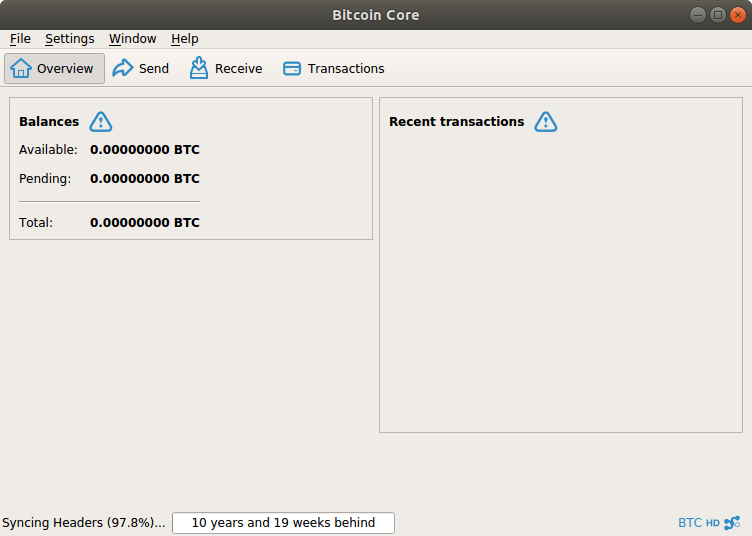
To get a deeper understanding of what a Bitcoin Node represents now, it is important to trace the evolution of Bitcoin Nodes from their inception in 2009 to the multifaceted roles they assume today.
The Beginning (2009)
Running bitcoin
— halfin (@halfin) January 11, 2009
When Bitcoin emerged in 2009 with Satoshi's client, every user "Running Bitcoin" was, in essence, a node. These early Bitcoin nodes had five essential functions:
- Download, Validate, and Forward: They downloaded, validated, and relayed blocks and transactions to other nodes.
- Transaction Creation: Nodes generated transaction templates for spending Bitcoin.
- Transaction Signing: They were responsible for signing transactions to enable spending.
- Candidate Block Creation: Nodes formed candidate blocks by assembling unconfirmed transactions from the memory pool, alongside previous block information.
- Proof of Work: Nodes solved Proof of Work puzzles, searching for the correct hash through numerous nonce field attempts (miners, basically).
In 2009, nodes were central to Bitcoin's operation and trustless by design, with resilience against manipulation except for the rare "reorg" attack, reliant on CPU power.
The Emergence of Mining Pools (2010)
In 2010, everything changed with the introduction of mining pools, pioneered by Slush (Trezor's founder). Mining pools allowed miners to collaborate, reducing the variance in rewards. This innovation marked the beginning of specialization in node roles.
Within mining pools, the responsibilities of nodes started to diverge. The pool's node handled downloading, validating, and forwarding transactions, as well as creating candidate blocks. Miners within the pool concentrated solely on Proof of Work.
Transition from CPU to GPU (2010)
In 2010, Bitcoin saw the shift from CPU mining to GPU mining. High-performance graphics cards became essential for mining, leading to a segmentation in the type of nodes that could efficiently compete in solving Proof of Work puzzles.
The Rise of Wallets (2011)
In 2011, wallets emerged as a distinct class of software. Mobile wallets, such as the first Bitcoin wallet on Android, and desktop wallets like Electrum, began to separate functions from the traditional node.
Wallets relieved nodes of some tasks, particularly transaction creation and signing. These wallets introduced another layer of trust as they relied on nodes to provide transaction information.
Introduction of ASICs (2013)
By 2013, ASICs (Application-Specific Integrated Circuits) entered the mining scene. These specialized machines focused solely on mining and could not perform node functions like downloading transactions or validating signatures. The network split roles further:
- Miners: Responsible for producing blocks through Proof of Work.
- Mining Pool Coordinators: Managed nodes for transaction processing and candidate block creation.
- Normal Users: Maintained nodes but no longer participated in block production due to hardware specialization.
The Era of Hardware Wallets (2013)
Hardware wallets like Trezor and Ledger emerged in 2013, providing enhanced security for Bitcoin storage. These devices specialized exclusively in transaction signing, devoid of node capabilities. Bitcoin Core continued to act as a node, while hardware wallets assumed the role of transaction signing.
Trezor One, developed by Trezor, holds the distinction of being the first hardware wallet ever created. Remarkably, it continues to be manufactured and available to this day. You can find a detailed review below.

Specialized Wallets (Today)
Today, specialized wallets have further evolved to address complex tasks like multi-signature transactions, fee estimation, and coin selection.
Software like Blue Wallet, Nunchuk, Sparrow Wallet, and Electrum cater to the needs of experienced Bitcoin users. Fewer individuals use Bitcoin Core as their primary wallet due to its rudimentary nature and lack of multi-signature and descriptor support.
The Evolution of Bitcoin Nodes
Bitcoin nodes have transitioned from all-encompassing entities in the network's early days to specialized roles, depending on the demands of the Bitcoin ecosystem.
The term "node" originally referred to a multi-faceted participant, but over time, it has become synonymous with software responsible for downloading, validating, and forwarding blocks and transactions.
Today, understanding Bitcoin nodes requires recognition of their diverse functions, including mining, wallet support, and transaction verification, as well as the emergence of hardware wallets and specialized wallet software. This evolution reflects the adaptability and resilience of the Bitcoin network over the years.
How To Run A Bitcoin Node
Learning how to run a Bitcoin node is not as complex as rocket science; it's akin to installing an operating system on a computer. Bitcoin has evolved over the years, with various updates and changes. However, a pivotal moment occurred during the blocksize war when a decision was made to keep the block size relatively small.
This decision was obtained after an unprecedented clash between proponents of small blocks and those advocating for larger ones. Small blockers championed the idea of smaller blocks to make it feasible for more people to run a Bitcoin node. On the other hand, big blockers argued for the opposite.
The rationale behind smaller blocks lies in several advantages. Firstly, smaller blocks mean a smaller blockchain to download. Secondly, they require less computing power. Lastly, there are fewer read and write operations on the hard disk because the block size is reduced.
Conversely, increasing the block size would result in higher storage costs and potentially reduce the safety and decentralization of the Bitcoin network.
How Much A Bitcoin Node Costs?
Running a Bitcoin Node involves various costs, primarily associated with hardware. These expenses can range from zero euros, especially if you repurpose hardware you already have lying around the house, as I did for my latest node (details will be explained later), to a few bucks if you opt for a Raspberry Pi and an HDD, or even a few hundred dollars for more advanced setups.
As of the time of writing, the most prevalent Bitcoin nodes are built using Raspberry Pi 4 hardware. This hardware consists of a compact computer board roughly the size of a credit card. In terms of power consumption, a Raspberry Pi 4 typically draws between 3 to 4 watts when idle. Additionally, power usage increases by 0.5 watts for each core that becomes active, peaking at 6 watts when all four cores are fully engaged.
If you leave the node operational for an entire year, it would consume approximately 43.8 kWh of energy. Assuming an energy cost of around $0.10 per kWh, the monthly power cost for running a node would be roughly $0.36, excluding internet expenses.
It's worth noting that the calculation does not include internet costs and energy usage for internet connectivity since it is assumed that you already have a broadband connection without data caps, which is highly recommended for running a node.
How To Setup A Bitcoin Node
"There are various methods to create a Bitcoin Node, and I'll discuss three primary approaches while also sharing my own experience later on. The choice of hardware and the definition of the 'best' Bitcoin node largely depend on your budget and your intended use. The value of a Bitcoin Node extends beyond economics; it also serves as an educational tool, enhancing your understanding of Bitcoin's inner workings.
- Recycle: This method is cost-free and involves repurposing existing hardware you have at home, be it a laptop or an old desktop. After selecting your hardware, you install a fresh and updated OS, preferably a lightweight, open-source version like Lubuntu. Then, you can download the official Bitcoin Core software from bitcoin.org or opt for dedicated solutions like Umbrel to create a node accessible within your network.
- Low Budget: If you don't have available hardware but still want to set up a node on a budget, consider using a Raspberry Pi 4 with 8GB (or even 4GB) of RAM and a minimum 1TB SSD. Alternatively, an Intel NUC is a viable option, albeit at a higher price point. You can install lightweight operating systems like UmbrelOS, designed for systems such as Umbrel, to keep resource usage to a minimum.
- Higher Budget: For those with a more substantial budget, there are pre-configured solutions like the Tanto by Ronin Dojo or the Umbrel Home by Umbrel. These compact devices come with pre-installed software, a 1TB or larger SSD, and higher RAM and CPU specifications compared to the Raspberry Pi.
I won't delve into the detailed configuration here; that will be covered in separate guides. However, in the next section I will showcase one of the nodes I've created using repurposed devices found around my house.
Getting the hardware (Device and Hard Disk)
As mentioned earlier, you have two options: purchase hardware or repurpose items you already have at home. Over the years, I've gathered various hardware pieces for different experiments, and while searching through my garage, I came across the following devices:
- Intel NUC N2820 (Purchased in 2013): Back in 2013, this was one of the more affordable NUC options, priced at around $100 for the barebone configuration. It didn't come with RAM or an SSD, which had to be bought separately. These mini PCs were quite popular a decade ago, especially during the Home Theater PC (HTPC) trend when people were experimenting with Kodi and other Linux-based media center devices. I tinkered with it briefly before transitioning to the Raspberry Pi, which had become the new favorite for HTPCs. This little computer, which consumes just about 5 watts when idle, ended up collecting dust for nearly 9 or 8 years.
- Icybox RAID Enclosure with two 1TB WD Blue Drives (Purchased around 2018): I acquired this RAID enclosure designed for two HDDs with USB 3.1 connectivity for approximately $150 (it's still available today). My initial intent was to store a multitude of PlayStation games on it. However, with the introduction of the newer PS5 and its USB compatibility limitations, this spinning hard disk setup became impractical for gaming. Consequently, these hard drives saw diminishing use. While WD Blue HDDs are reliable for extended operation, SSDs are preferable for a Bitcoin Node due to their superior performance in handling the read and write demands of blockchain validation. Nevertheless, since I wasn't in a hurry to sync the blockchain, these hard drives were excellent candidates for repurposing in a Bitcoin Node setup.
- Tecnoware UPS (Purchased around 2018): This might seem like overkill, but it's cost-effective (under $100). I value uninterrupted operation for my Bitcoin nodes because, sometimes, unexpected power interruptions can corrupt data on the hard drive if it's actively in use. With the UPS in place, everything runs smoothly all the time. It's worth noting that UPS units require occasional maintenance, including replacing the battery every few years.
- Monitor: A small touchscreen monitor originally designed for Raspberry Pi systems but compatible with various devices. I connected it to the NUC, enabling manual access for troubleshooting situations when network-based access via IP wasn't feasible. While I can't recall the exact cost, it likely amounted to less than $50.
- Fritz! Box 7530 Modem/Router: Part of my broadband internet contract, this router is vital for ensuring fast and reliable internet connectivity—a crucial factor for maintaining node availability. The router should have ethernet ports (to connect the node via cable and have less latency) and offer extensive customization options, especially if you plan to enable incoming connections on your node, necessitating port forwarding settings to accommodate clearnet-only peer connections.
These constitute the core components of my setup. In the image, you may spot additional devices like a camera and a Raspberry Pi. The Raspberry Pi functions as a recursive DNS with Unbound and Pi-hole, while the camera, an old Arlo model, is unrelated to the Bitcoin Node setup.
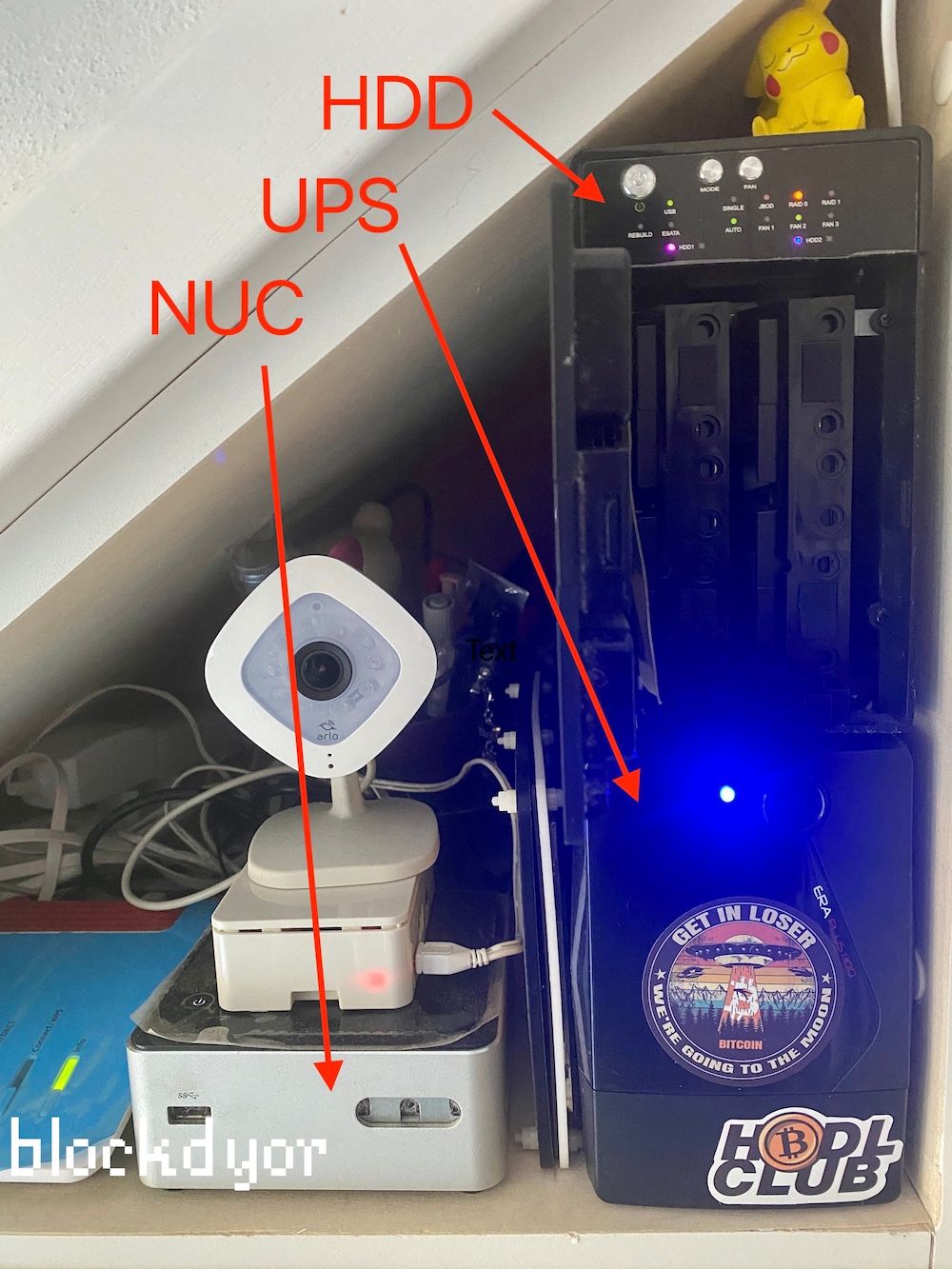
Researching and Installing the software
Selecting the right software can be a time-consuming process, potentially even more so than choosing the hardware. The software options available today are numerous, and they offer different approaches. You can either opt for a do-it-yourself solution by installing Linux and then Bitcoin Core, or you can choose from specialized software packages with an integrated app store that simplifies the process.
Notable software options include Start9, Umbrel, MyNode, and many others. It's worth noting that all of these solutions are open source, providing the transparency to independently verify each build.
If you have a Raspberry Pi, it's often more convenient to go with a dedicated operating system like UmbrelOS, purpose-built for Bitcoin Nodes. However, if you're using generic hardware, you'll typically need to follow a two-step process: first, install a Linux distribution, such as Ubuntu, and then install the Bitcoin Core software. For the sake of illustration, let's consider the example of installing Umbrel on top of a Linux distribution since there isn't a dedicated UmbrelOS for generic hardware.
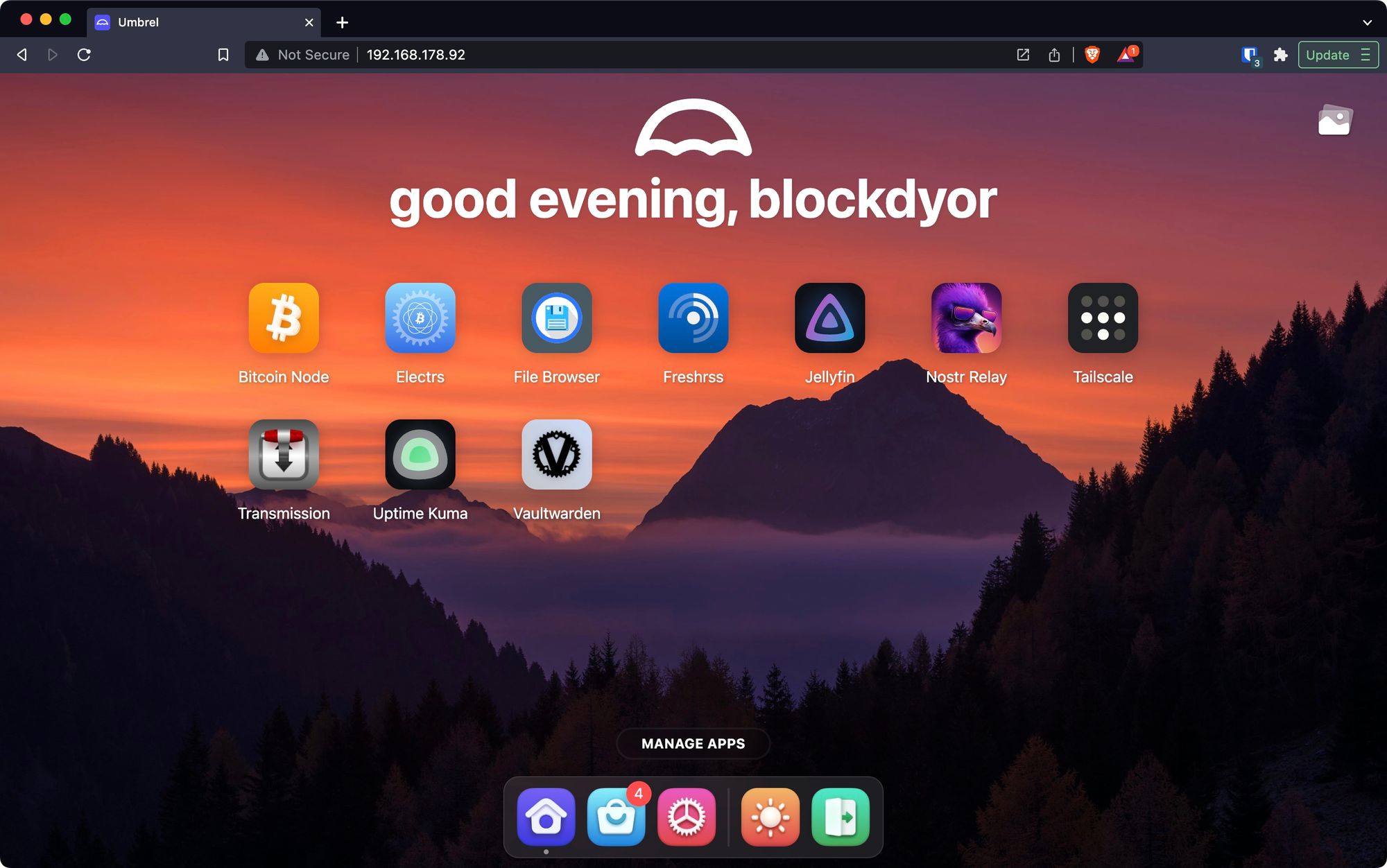
This is how the Umbrel homepage appears when you access it from another device within your network, using the IP address where it's installed, which in this case is 192.168.178.92.
As you can observe, my setup isn't limited to just a Bitcoin Node; Thanks to the Umbrel App Store, I've downloaded other apps, including a self-hosted Bitwarden server (Vaultwarden), a Nostr Relay, a media center (Jellyfin), and a range of additional applications and features.
Running Bitcoin
So, running Bitcoin means running a full node. And in order to do that on Umbrel, I just had to go on the app store and download it.
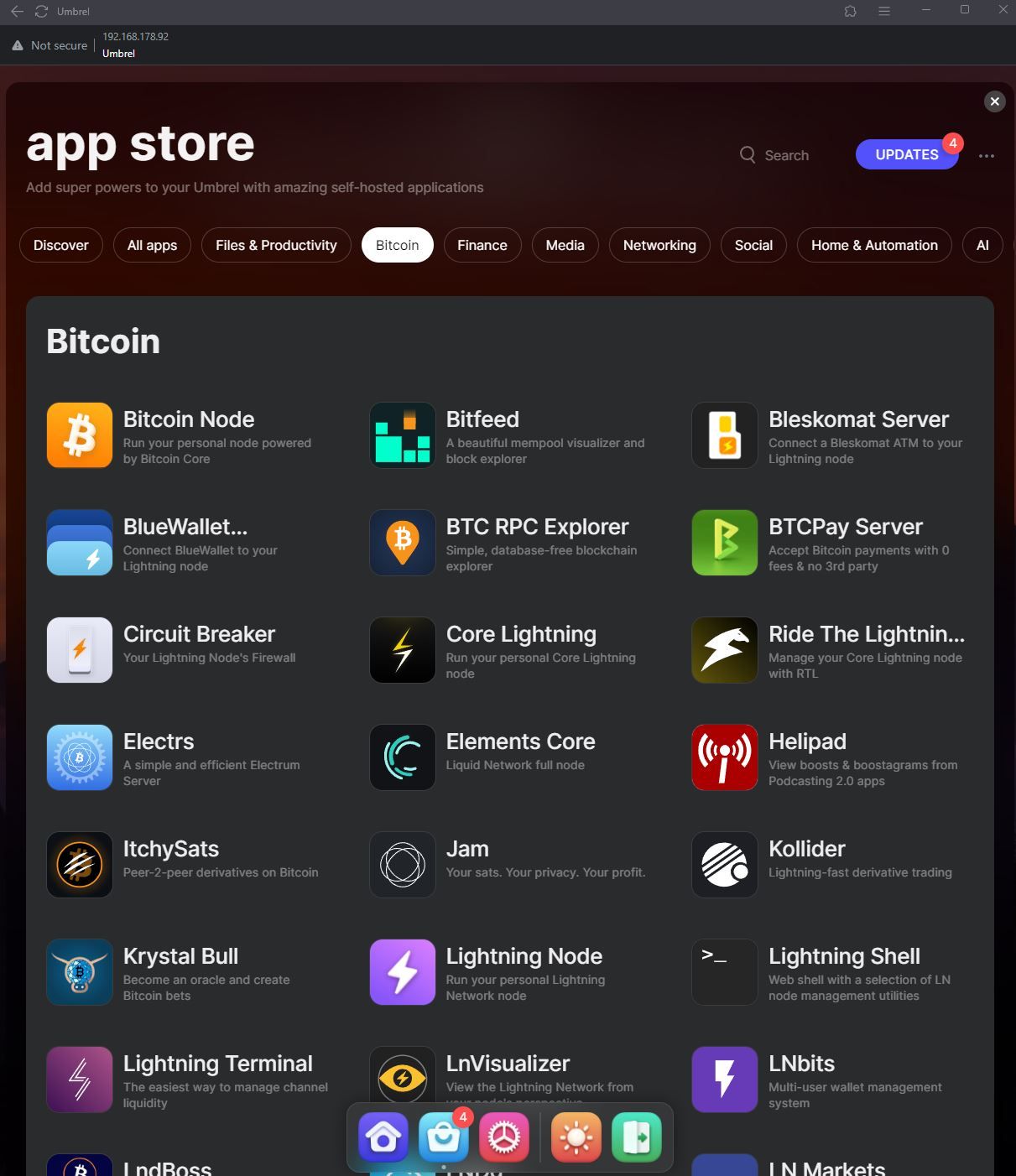
There are countless app, but in this case you just need to download the "Bitcoin Node" app, which is a personal node powered by Bitcoin Core.

Initial Block Download (IBD)
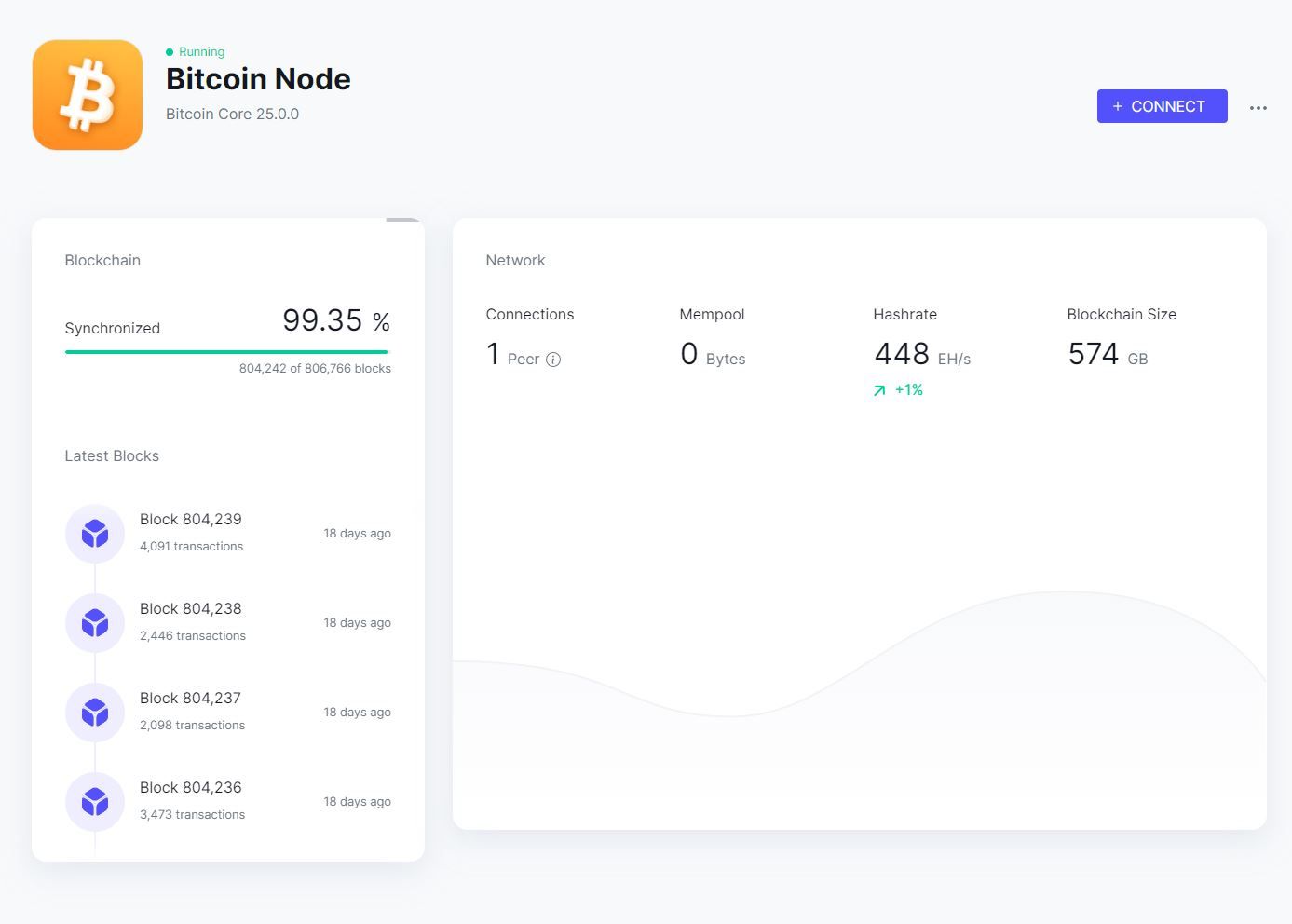
Once you've connect to the power the hardware, installed the necessary software, and added the Bitcoin Node app, your node will start the process of downloading and validating the entire blockchain. This blockchain contains the complete history of all Bitcoin transactions, from its inception with the genesis block in 2009 up to the present day. Currently, the blockchain's size is in the several hundred gigabytes range, so it's expected that this Initial Block Download (IBD) will take some time.
As a general guideline, the duration of this task depends on the speed of your hardware and internet connection. With a fast SSD and modern hardware, it might take just a few days. However, if you're using a spinning HDD and older hardware, it could extend to weeks or even months.
It's worth noting that the initial part of the IBD, up until around 2017, proceeds notably faster than the subsequent portion. This disparity is due to a significant protocol upgrade in 2017 known as Segregated Witness (SegWit). Prior to SegWit activation, Bitcoin blocks adhered to a strict 1MB size limit. With SegWit, block size is measured by weight rather than size, allowing for a maximum block size of 4 MB.
Bitcoin Node Minimum Requirements
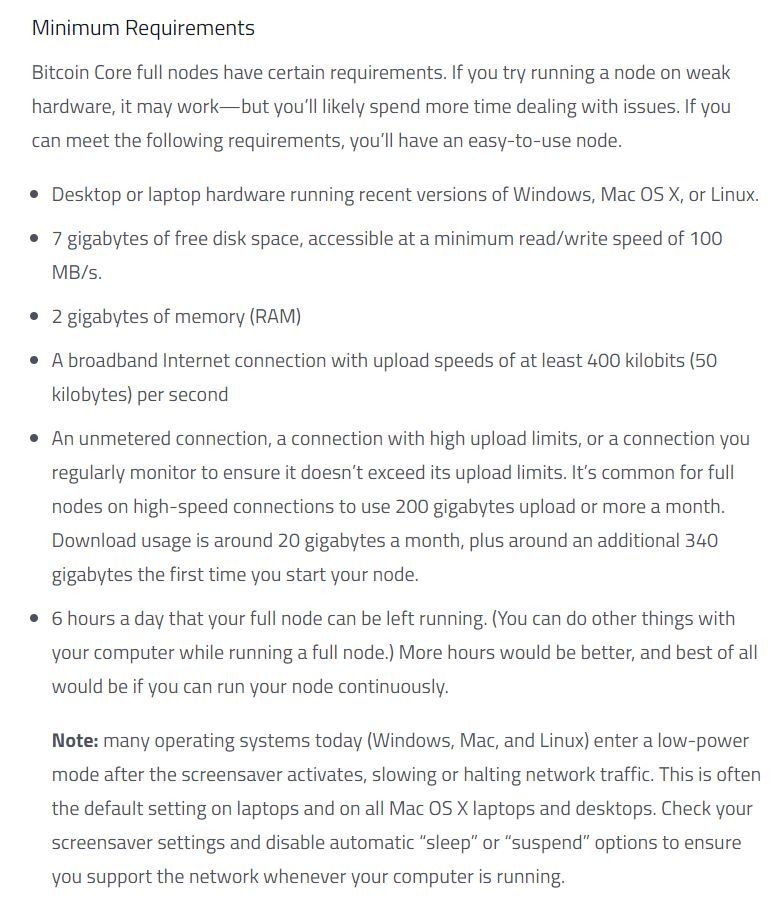
The official Bitcoin website (Bitcoin.org) offers some guidance regarding the minimum requirements for running a Bitcoin Node. While most hardware setups should suffice, it's considered ideal to have a minimum of 100 Mbps internet speed or a hard disk with read/write speeds of at least 100 Mbps.
The specified minimum storage requirement is 7 GB, but this is intended for lightweight "pruned" nodes. However, running a pruned node may not provide the full spectrum of security and privacy benefits. The entire Bitcoin blockchain currently occupies around 600 GB of storage and continues to grow at a rate of approximately 50 GB per year.
Hence, a 1 TB drive should serve you well for approximately 6 years, which is a reasonable timeframe. However, if you aim to future-proof your node for an even more extended period, opting for a 2 TB drive will provide ample storage capacity for over 20 years of operation.
It's worth noting that many Bitcoin Node software options include backup functionalities, allowing you to upgrade your storage over the years as needed, without having to re-download and verify the blockchain all over again.

How Many Bitcoin Nodes There Are In The World? And Where They Are?
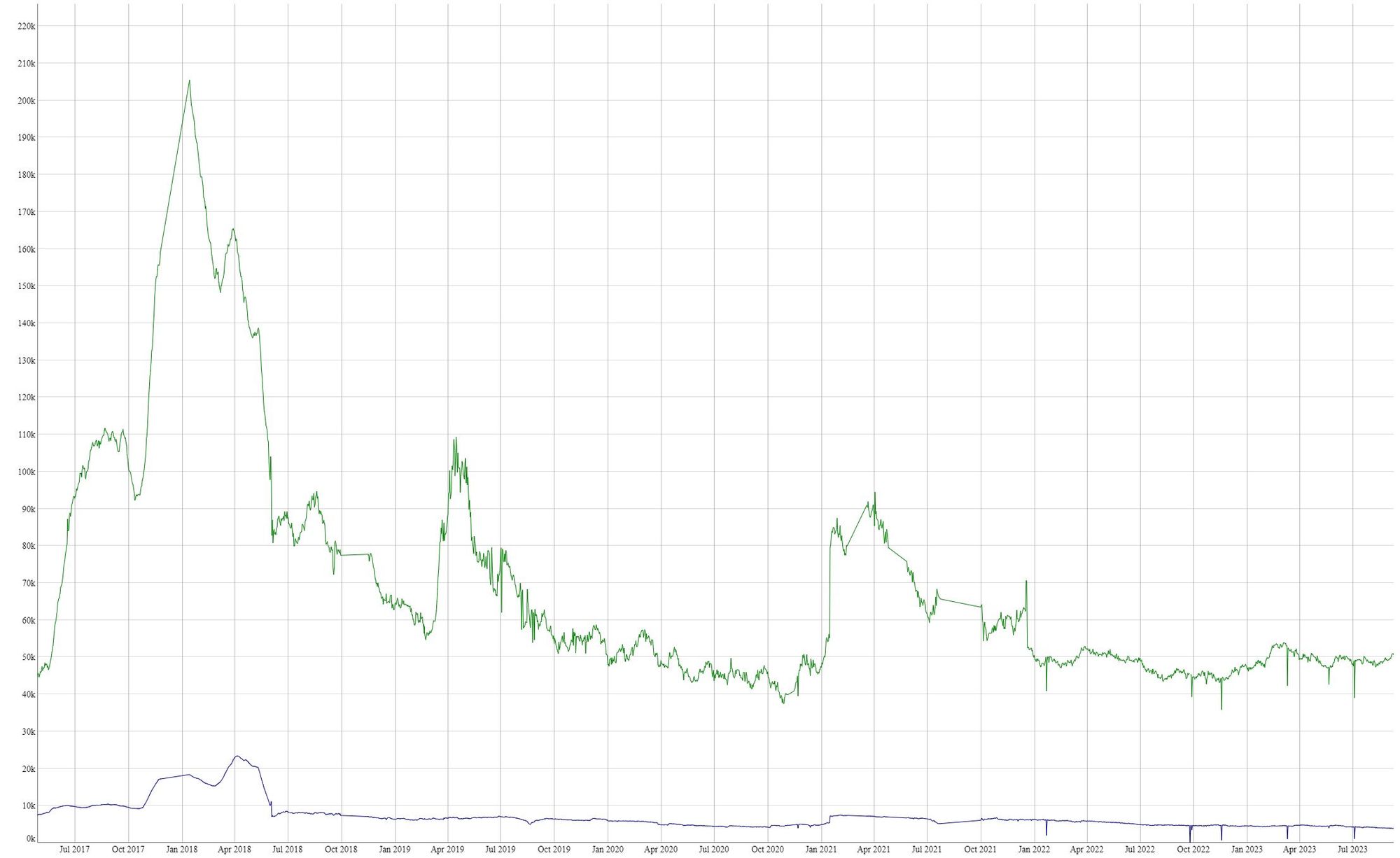
Full node runners are the unsung heroes of the Bitcoin ecosystem, scattered across the globe. They rightfully hold the title of the most vital contributors to Bitcoin's success. These dedicated individuals choose to run the Bitcoin software, often with little direct compensation, yet their role is pivotal to the entire system's functioning. Bitcoin's very existence and security rely on their commitment.
Typically, websites like Bitnodes (see the next screenshot) primarily tally "listening nodes" – nodes configured to actively listen for incoming connections and, as a result, share the Bitcoin blockchain with others.
However, it's essential to note that the vast majority of Bitcoin nodes are non-listening, making it challenging to provide an exact count of all Bitcoin nodes.
Nevertheless, Luke Dash Jr, a Bitcoin Core developer since 2011, offers an estimate along with historical data on his website (see the previous screenshot).
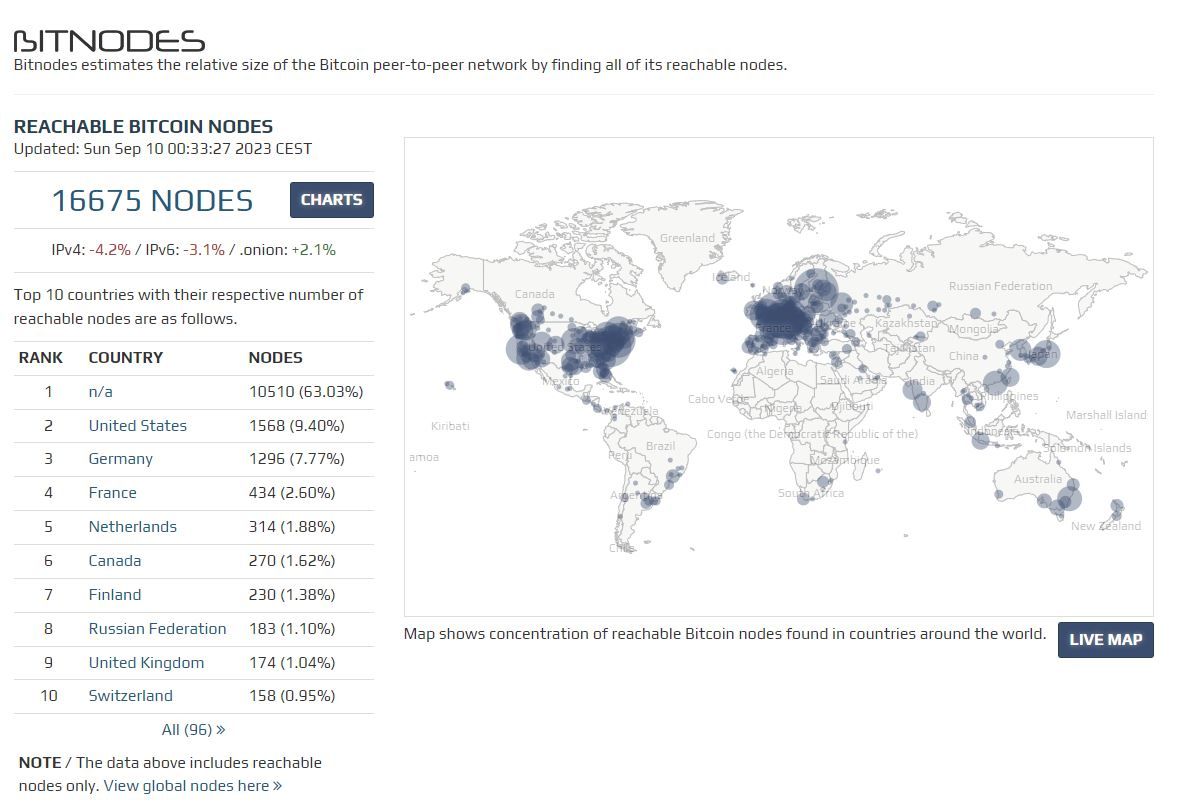
These node operators hail from diverse corners of the world, with distinct beliefs, languages, and life experiences. Despite these differences, they share a common vision: the belief that money should be a freely accessible public resource, not controlled by any central authority.
Bitcoin's security is fortified by the widespread distribution of these nodes, making it nearly impossible to compromise the system by targeting a single individual, building, city, country, or even an entire continent.
This robust defense mechanism sets Bitcoin apart from its imitators, rendering them unable to match its resilience.
Bottom Line
The history of Bitcoin Nodes is a journey from a single, all-encompassing entity in 2009 to a diversified ecosystem of specialized roles today. Nodes initially handled everything from transaction validation to block creation and mining, with every user operating one. However, the advent of mining pools, GPU mining, and hardware wallets led to the segmentation of these functions.
Today, Bitcoin Nodes come in various forms, from DIY setups on recycled hardware to purpose-built devices. You can choose between low-budget options like Raspberry Pi or opt for more powerful, pre-built solutions like Umbrel Home, or Ronin Dojo Tanto (and many other more). Regardless of your choice, the goal remains the same: to self-validate and contribute to the security and decentralization of the Bitcoin network.
As Bitcoin evolves, so do its nodes, showcasing the adaptability and resilience of this revolutionary digital currency.
Whether you run a Bitcoin Node for ideological reasons, practical purposes, or are here to gain insight into the technicalities, I extend my sincere appreciation to you. Your contribution plays a vital role in upholding the principles and functionality of the Bitcoin network.


